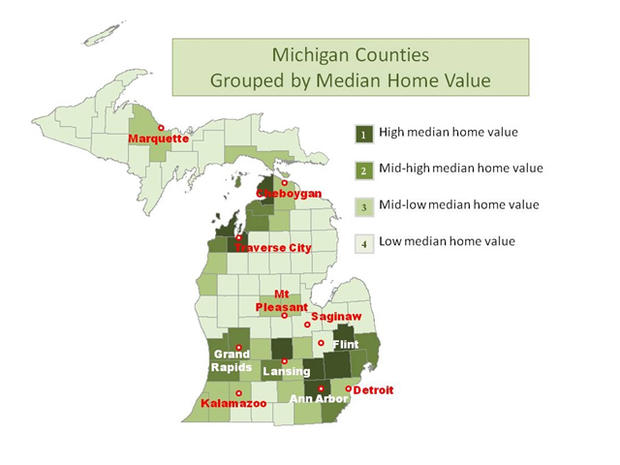Viewer's guide: The Michigan primary
For Mitt Romney, it's an unexpected battleground - not only because it was his family's home state but because the electorate's profile might have seemed favorable to him. But for Rick Santorum, that also means Michigan is a prime opportunity, not only to rally conservatives but to notch a win in a high-turnout, high-profile primary where perhaps one million votes will be cast. The pre-election polls show this race is close. Here are some things to watch:
The Landscape: Start by watching Grand Rapids on the western side of the state: this is reliably Republican, conservative territory, and probably where Santorum needs to do well and run up the score. (In general elections, it is not uncommon for the GOP to get six or seven in 10 votes in places like Kent and Ottawa counties.) Candidate Mike Huckabee did his relative best here in 2008; conservative Pete Hoekstra did his best here in the 2010 primary against current Gov. Rick Snyder.
The Grand Rapids area will likely cast perhaps 22 to 24 percent or so of the votes statewide (a larger share of the votes than it does in a general election because of its heavily Republican electorate.) If that reaches 25 percent and higher it may mean a good night for Santorum. Seemingly small differences like that can amount to be numerical swings in a tight race. If Romney does well elsewhere, but turnout keeps Grand Rapids and environs around or under 20 percent of the statewide vote, that will be a good sign for Romney.
Next turn to the suburbs of Detroit. Wayne county, which in percentage terms has more Democrats but numerically will have plenty of Republicans. Nearby, watch more affluent Oakland County, and also Macomb, made famous as the home of swing voters and "Reagan Democrats" a generation ago. Romney will rely on this area. He's done well with upper-income Republicans in the primaries so far this year, and he'll find plenty of them there; he did well in the region in 2008. This was also where Gov. Snyder, who endorsed Romney, did best in his own primary. Also, pay attention to how views on the auto bailout plays here: does it help Romney among principled conservatives or hurt him in this automotive center? Here's how to watch turnout: if he's doing well and these areas make up about one-third of the statewide vote, that's a good sign, and perhaps enough to overcome a deficit, if there is one, in Grand Rapids.
The center part of the state could be a swing area. From Lansing to Flint, this region is a mix of more moderate and conservative counties; if Santorum is pulling in more working-class and middle-class Republicans, it'll show up here.
Which brings us to the voter groups: Santorum has gone hard after those middle- and working-class Republican voters. If past primaries are an indication, this will be a real battle. In these primaries, Mitt Romney has performed strongly among upper-income Republicans in the states he has won, and Romney has actually done quite well among those earning under $50,000 too. The notable difference was South Carolina, where he lost among all income groups en route to losing the state. In recent Michigan primaries as well as in the early states this year, that figures to be around one-third of the electorate.
Income isn't the only way to watch the economic breakdown of candidate support. Another way is to look at housing values by county, which can be a good measure of overall wealth that also incorporates age. Seniors - a critical voting bloc - often have lower actual incomes even if they have assets, and it, too, reflects some of the same breakdowns we see regionally. In the chart below, we see that counties with the highest home values around Detroit, which we'd expect to go for Romney if he's having a good night.
Very conservative voters have also been a focal point for the Santorum campaign. The electorate in Michigan is not usually dominated by evangelicals and very conservative voters, as it has been where either Santorum or Gingrich have done well, so it'll be key to watch turnout among these groups. In Iowa, for example, more than half of caucus-goers were evangelical Christians and nearly half considered themselves very conservative, as opposed to only somewhat conservative. But Michigan in 2008's primary had fewer of both: evangelicals accounted for 36 percent of voters and one-quarter were very conservative.
Pay particular attention to the split between very conservative and somewhat conservative voters, as well as moderates. In the primaries thus far, Mitt Romney has done very well among the "somewhat" conservative and moderates, but not always well among the "very" conservative. In Florida, for instance, even as he easily won the state, he lost the very conservative vote. Romney won it, though, in Nevada and New Hampshire, so the size of that group - whether it remains around one-fourth or if it reaches above one-third, perhaps - could be an important indicator, especially if Santorum wins it. Where exit polls are available so far moderate voters have tended to heavily prefer Romney over Gingrich or Santorum.
And a few other things to consider: First, absentee ballots will matter here. They could likely be one-fifth of the votes, with around 200,000 in so far. Mailed-in ballots put a premium on organization (campaigns help people request and remember to return them) and that may favor Romney. However, the timing of when they're cast matters too, and the tallies could reflect some of the positive news surrounding Santorum's recent wins. Also, some have pointed to crossover voting from Democrats as possibly playing a role. Worth watching, perhaps, but with a million votes expected, it would really take a lot of Democrats to swing a race, and so far this primary season when Democrats had the chance to participate (in New Hampshire and South Carolina) they simply have not taken it, numbering just around 4 percent.


